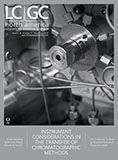HPLC Column Maintenance: Tips for Extending HPLC Column Lifetime
While the relative cost of HPLC columns has been reduced over time, extending column lifetime remains an important consideration for most laboratories. The following tips should help to protect your columns and significantly extend the useful lifetime of most phases.
Always read the manufacturer's literature with respect to the recommended pressure, eluent pH and temperature operating ranges for the column, and stick to these ranges.
Note that higher operating temperatures often go hand in hand with reduced pH operating ranges. At low pH, the main symptom of column degradation is typically loss of efficiency (peak broadening) and at high pH, peak tailing and an increase in column back pressure.
Avoid mechanical shock of the column bed, such as dropping the column, and ramp the pressure or flow slowly (1 mL/min/min is ideal) each time eluent flow is initiated.
Most modern HPLC equipment is capable of achieving this flow or pressure ramp automatically through secondary instrument settings. Bed voiding due to pressure shock often manifests itself via split or very badly tailing peaks. Columns may be reversed for analysis if a replacement is not readily available; however, the efficiency of the column is likely to reduce much more quickly as the bed will ultimately slump in the opposite direction, leading to the same chromatographic symptoms.
If columns have dried out, initiate the flow very slowly (0.1 mL/min/min) using an eluent containing at least 50% acetonitrile.
If a "standard" (non "aq" or non-polar embedded phase type) reversed-phase column is suspected of phase collapse (shortening retention times, poor efficiency) due to use with 100% aqueous mobile phases, the column should be reactivated at high flow with 100% acetonitrile at 60 °C (take care to not precipitate any solid buffers from the eluent remaining within the column). In both of these cases, between 50 and 100 column volumes may be required to properly re-equilibrate or re-activate the phase.
Columns should be properly washed after each use.
A recommended washing routine may be:
- Current content to 90% acetonitrile at 10% organic per 2 column volumes and hold for 10 column volumes (again take care to avoid precipitation of solid buffers by ramping the acetonitrile concentration slowly, as recommended here).
- 10% acetonitrile per 2 column volumes to 50:50 acetonitrile:water and hold for 10 column volumes.
- Remove from the system, end cap and store. End capping of the column is very important to avoid the phase drying out.
One might use an older HPLC system as a column "wash station," which can save significant amounts of operating time on "live" instruments.
If samples are likely to contain particulate matter, choose a good quality inline filter with the appropriate mesh size; 0.45 µm for traditional columns and 0.2 µm for UHPLC columns is typical.
If the sample matrix or diluent is likely to harm the sorbent (due to pH, for example) or is particularly chemically dirty or intractable, a guard column may be used, and the phase should be matched with that of the analytical column. Take great care when selecting the dimensions of the guard column and connecting to the analytical column to ensure that the efficiency of the separation is not compromised.
If column or frit contamination is suspected due to peak splitting or loss of efficiency, it is possible to reverse the direction of the column for back flushing purposes, and the column washing procedure mentioned above is a good "recipe" for this purpose.
One should uncouple the column from the detector to avoid fouling, and note that reversal for flushing should only be used as a matter of last resort, and that the original efficiency of the column may not be achieved.
Remember that column volume may be estimated using π × r2 × L × 0.6 (the approximate interstitial porosity of silica used for HPLC column packing materials).
So, for a 150 × 4.6 mm column, this would approximate to:
3.142 × (2.3)2 × 150 × 0.6 = 1.496 µL or ~1.5 mL
These tips will help extend your column lifetimes.

Regulatory Deadlines and Supply Chain Challenges Take Center Stage in Nitrosamine Discussion
April 10th 2025During an LCGC International peer exchange, Aloka Srinivasan, Mayank Bhanti, and Amber Burch discussed the regulatory deadlines and supply chain challenges that come with nitrosamine analysis.












